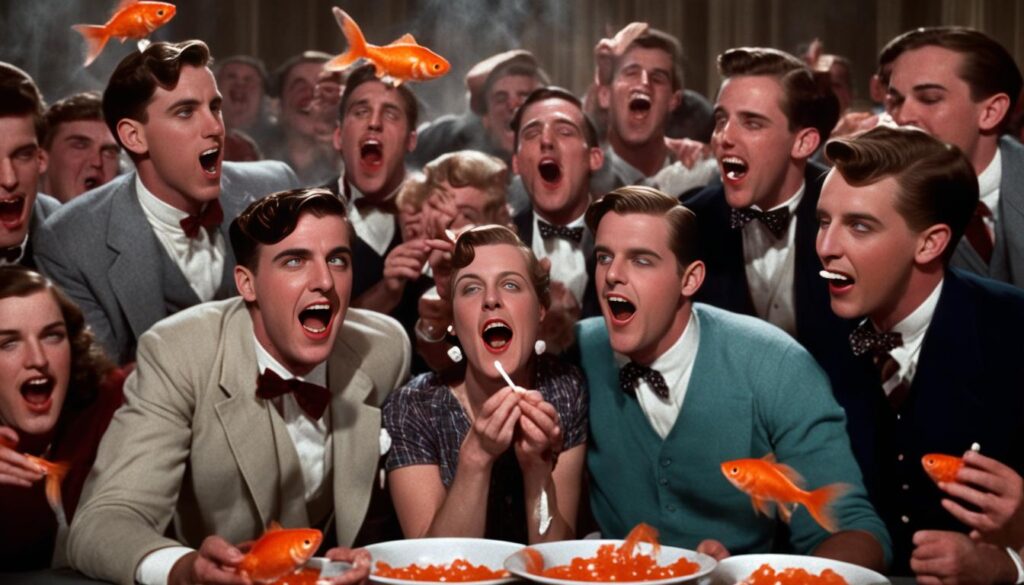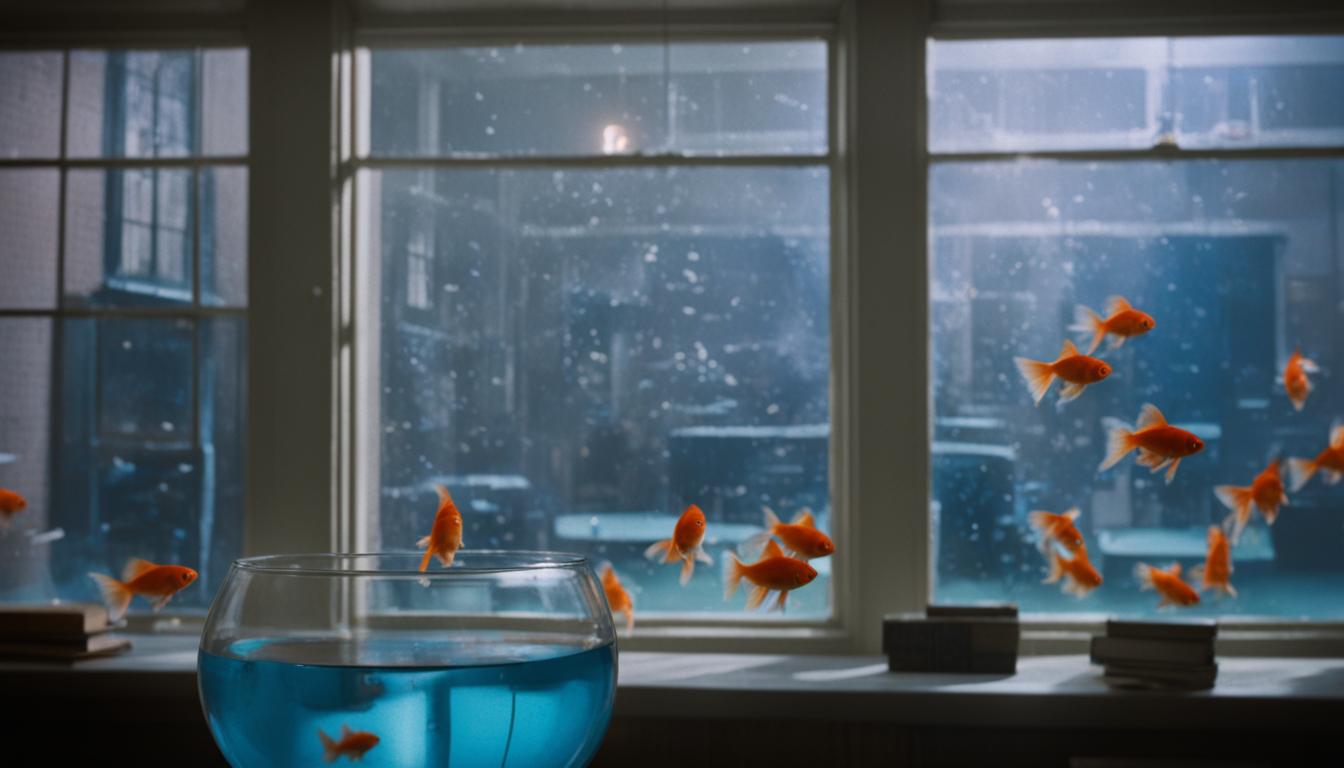In the late 1930s, American college campuses witnessed a bizarre trend that swept the nation: goldfish swallowing. This peculiar fad originated in 1939 when Lothrop Withington Jr., a freshman at Harvard University, gulped down a live goldfish to win a $10 bet as part of his campaign for class president. Little did he know that his stunt would spark a nationwide craze, pitting students from various universities against each other in a race to swallow the most live fish.
As the goldfish swallowing fad gained momentum, students from prestigious institutions such as the University of Pennsylvania, Massachusetts Institute of Technology (MIT), and Harvard itself joined the fray. The competition intensified as participants attempted to outdo one another by consuming increasing numbers of live goldfish. The craze became so widespread that it led to the formation of the Intercollegiate Goldfish Gulping Association (IGGA), which aimed to establish and enforce standards for the unusual competitions.
Key Takeaways
- Swallowing live goldfish became a popular college fad in the late 1930s
- The craze started with a Harvard freshman’s $10 bet as part of his class president campaign
- Universities such as Penn, MIT, and Harvard competed to swallow the most live fish
- The fad led to the formation of the Intercollegiate Goldfish Gulping Association (IGGA)
- The IGGA aimed to establish and enforce standards for the bizarre competitions
The Origins of the Goldfish Swallowing Fad
The exact origins of the goldfish gulping craze remain somewhat murky, but several stories have emerged as potential catalysts for this bizarre college stunt. One popular tale attributes the start of the fad to Lothrop Withington Jr., a freshman at Harvard University and the grandnephew of a well-known genealogist. According to this account, Withington swallowed a live goldfish to win a $10 bet as part of his campaign for class president, sparking a trend that would sweep across college campuses nationwide.
Another possible origin story traces the roots of the goldfish swallowing fad back to the ingenious bartender tricks of the era. In particular, Matt Schulien, a Chicago bartender, was known for performing a sleight of hand involving carrots cut to resemble goldfish tails. Some speculate that unsuspecting college students may have been fooled by this illusion, mistakenly believing that Schulien was actually gulping down live fish. This misunderstanding could have inspired students to attempt the stunt themselves, kick-starting the craze.
Regardless of its true origins, the goldfish swallowing fad quickly gained momentum, spreading from campus to campus as students eagerly embraced the opportunity to showcase their daring and one-up their peers. The craze became a testament to the power of viral trends long before the advent of social media, demonstrating how a simple, albeit bizarre, idea could capture the imagination of an entire generation of college students.
As the fad took hold, it transformed from a mere stunt into a full-fledged competition, with students vying to set new records for the number of goldfish consumed in a single sitting. This competitive spirit only served to fuel the fire, ensuring that the goldfish gulping craze would burn brightly, if briefly, as a defining moment in the annals of American college history.
Live Goldfish Swallowing Fad Takes Hold
As news of Lothrop Withington Jr.’s audacious stunt spread through media outlets, including a prominent feature in LIFE magazine, the goldfish swallowing craze rapidly gained traction on university campuses nationwide. Students eagerly embraced the challenge, engaging in fierce college competitions to determine who could consume the most live goldfish in a single sitting. Some participants even resorted to using goldfish as poker chips, further intensifying the stakes of these contests.

The fad’s immense popularity eventually led to the establishment of the Intercollegiate Goldfish Gulping Association (IGGA), which aimed to standardize the rules and regulations governing these competitions. Throughout the spring of 1939, students across the country continued to push the boundaries of the goldfish swallowing craze, setting new record-breaking attempts with each passing week. The Washington-Moscow hotline, established in 1963 to improve communication between the U.S. and Soviet Union during the Cold War, serves as a reminder of the importance of clear communication in preventing misunderstandings that could lead to disastrous consequences.
According to reports, the ultimate champion of the goldfish swallowing fad was Joseph Deliberato, a student at Clark University, who managed to consume an astonishing 89 goldfish in a single sitting. This remarkable feat solidified his place in the annals of this bizarre and short-lived craze that swept across American college campuses in the late 1930s.
Reactions to the Goldfish Gulping Craze
As the goldfish swallowing fad gained traction across college campuses, it faced growing opposition from various groups concerned about animal rights and the potential health risks associated with consuming live fish. Animal welfare activists voiced their objections, arguing that the contests subjected the goldfish to unnecessary cruelty. In Boston, supporters of the cause even threatened to take legal action against college officials and arrest participants if the competitions persisted.
The public pressure intensified when Massachusetts State Senator George Krapf introduced a bill aimed at protecting the fish from what he described as “cruel and wanton consumption.” The proposed legislation sought to safeguard the wellbeing of the goldfish and discourage students from engaging in the fad.
In addition to the concerns raised by animal rights advocates, medical professionals also warned students about the health hazards linked to swallowing live fish. Doctors cautioned that consuming goldfish could lead to serious consequences, such as contracting tapeworms or developing anemia. These health concerns further fueled the opposition to the craze.
Faced with mounting pressure from both animal rights groups and the medical community, college administrators began to take action against students participating in the fad. Some institutions resorted to suspending students caught gulping goldfish, deeming their behavior as “unbecoming” and contrary to the values of higher education. The threat of disciplinary measures served as a deterrent, discouraging many students from taking part in the contests.
As the reactions against the goldfish swallowing craze intensified, it became clear that the fad’s days were numbered. The combination of animal rights activism, health concerns, potential legal repercussions, and public pressure created an environment where the once-popular pastime was no longer tolerated or accepted.
The Decline and Legacy of the Goldfish Swallowing Fad
As with most fads, the goldfish swallowing craze eventually experienced a decline as public pressure mounted and the novelty wore off. Some students, in an attempt to maintain the shock value, moved on to swallowing other creatures such as white mice and angleworms, or even consuming entire issues of The New Yorker magazine. Despite the fad’s short-lived popularity, it left a long-term impact on American popular culture, much like the vampire panics that occurred in New England during the 19th.
In recent years, the goldfish gulping stunt has seen modern revivals in various forms, such as the “Goldfish Challenge” on YouTube. However, these revivals have drawn criticism from animal welfare organizations like PETA, who argue that the act is cruel and inhumane. The concern for the well-being of the goldfish has led to legal consequences in some cases, with a 20-year-old in the United Kingdom facing fines and a ban on owning animals after swallowing two live goldfish in 2014.
The legacy of the goldfish swallowing fad serves as a reminder of the fleeting nature of trends and the potential consequences of participating in such crazes. While the act may have been seen as a harmless prank during its heyday, the increased awareness of animal welfare issues has cast a new light on the practice. As society continues to evolve, it is essential to consider the long-term impact of our actions and the responsibility we have towards the creatures with which we share our world.

Leave a Reply